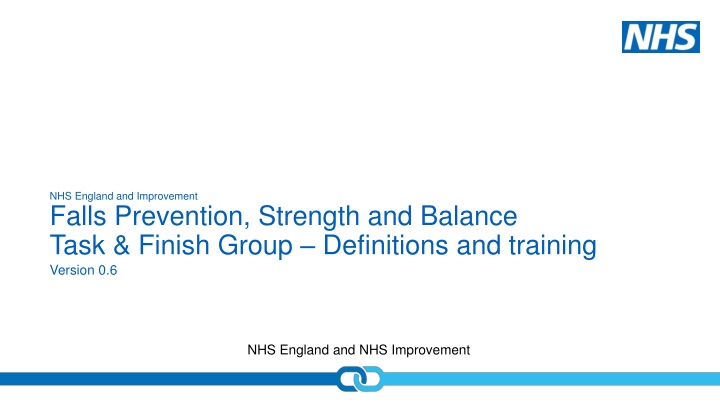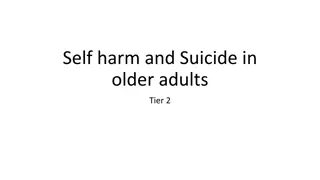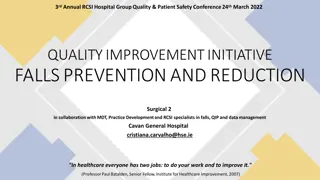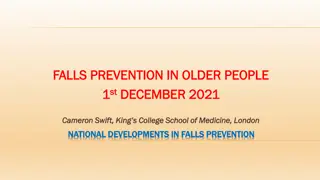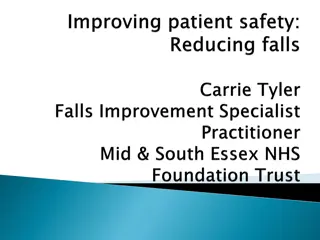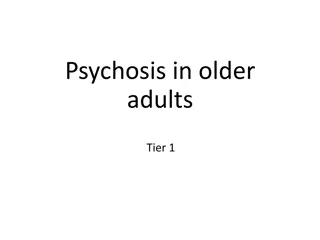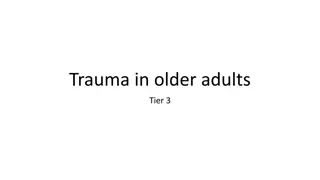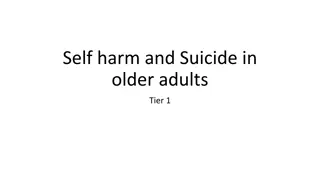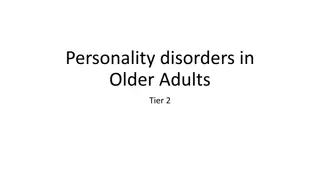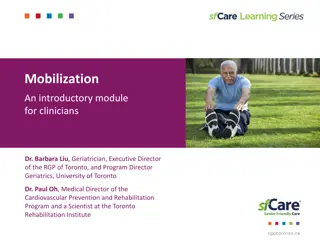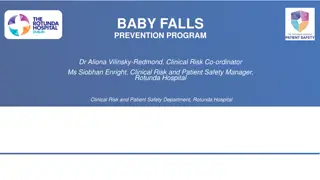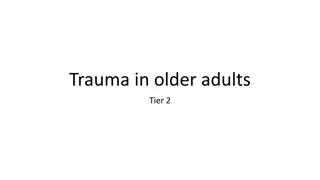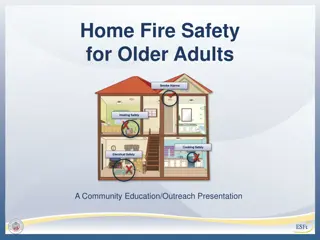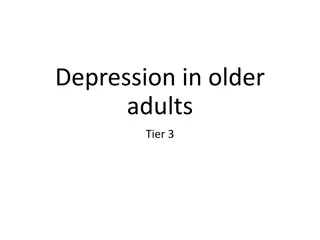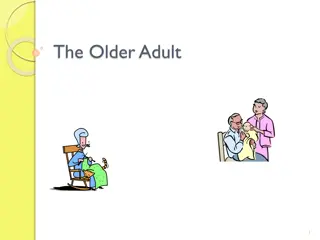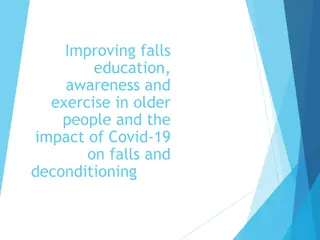Falls Prevention and Strength Training in Older Adults
Falls prevention and strength training are vital components in maintaining the health and well-being of older adults. The content discusses the definition of falls, reasons why people fall, consequences of falls, deconditioning, and strategies for reducing fall risks. It emphasizes the importance of awareness, risk factors, and personalized care plans in preventing falls and their severe impacts on individuals, particularly in care home settings.
Download Presentation

Please find below an Image/Link to download the presentation.
The content on the website is provided AS IS for your information and personal use only. It may not be sold, licensed, or shared on other websites without obtaining consent from the author.If you encounter any issues during the download, it is possible that the publisher has removed the file from their server.
You are allowed to download the files provided on this website for personal or commercial use, subject to the condition that they are used lawfully. All files are the property of their respective owners.
The content on the website is provided AS IS for your information and personal use only. It may not be sold, licensed, or shared on other websites without obtaining consent from the author.
E N D
Presentation Transcript
NHS England and Improvement Falls Prevention, Strength and Balance Task & Finish Group Definitions and training Version 0.6 NHS England and NHS Improvement
Key Knowledge and Skills 1. What is a fall? 2. Why do people fall, who is at risk and how do we reduce that risk? 3. What are the consequences of a fall? 4. What is deconditioning? 5. What to do when someone has fallen? 6. What is strength and balance training?
1. 1. What is a fall? What is a fall? Definition Resources A fall is defined as an event which results in a person coming to rest on the ground/floor or other lower level, for example a chair. Videos Later Life Training - Bex and Dawn's Glossary of Terms part 1 (Video - 14.29) React to Falls Part 1 What is a fall and why is it important to prevent falls? (Video 7.21) Documents Web Pages All Our Health (AOH)- Falls and Fractures eLFH (Web Page) Public Health England - Falls: Applying All Our Health (Web Page)
2. 2. Why do people fall, who is at risk and how do we reduce that Why do people fall, who is at risk and how do we reduce that risk? risk? Definition Resources As we get older or more unwell, falls can become more common and the consequences of a fall can become much more serious. We need to be aware of the risks that could lead to falls. Some examples are: Those living with moderate or severe frailty. Requiring walking aids to move about the home. Taking multiple medications. Cognitive decline. Person needs glasses. Having a history of falls. Videos Cardiff and Vale University Health Board - Falls Prevention Fuel Tank (Video - 6.24) React to Falls Part 2 Why do residents fall and what are the risks? (Video 7.27) React to Falls Part 3 React to reduce the risk of falls (Video - 8.52) Documents Web pages We need to recognise and work with residents where possible to reduce potential causes for falls. Some examples could be: Loose fitting clothes. Poorly fitting footwear or foot sores. Trip hazards, such as rugs or loose mats. Slippery surfaces. Poorly lit spaces. NHS Falls Overview (Web Page) It is important to understand the people that you are providing care for and whether they have any risk factors for falls; these should be detailed in the person s Personalised Care and Support Plan.
3. 3. What are the consequences of a fall? What are the consequences of a fall? Definition Resources Falls and the consequences of falls can significantly impact a person s wellbeing, mobility and confidence. People living in care homes are much more likely to fall due to their complex needs and consequences of these falls can be serious, including fatal. No resources here however may be covered by earlier resources Videos Documents Falls are the second leading cause of deaths from unintentional injury worldwide and adults older than 60 years of age suffer the greatest number of fatal falls. Web Pages Physical consequences from a fall can be a direct injury which results in a loss of ability to carry out their usual daily activities. For residents who are very frail this loss of ability may be permanent because of their complex conditions. As well as the pain from injury, a fall can be psychologically distressing for residents resulting in a loss of confidence, increased anxiety, and being fearful of it happening again. When a person falls and waits for a long period of time for assistance, there can be additional physical and psychological consequences including pressure sores, hypothermia and developing a deep fear of further falls.
4. What is deconditioning and what is the impact of reduced 4. What is deconditioning and what is the impact of reduced activity? activity? Definition Resources Deconditioning is the syndrome of physical, psychological and functional decline that occurs as a result of prolonged inactivity and associated loss of muscle strength. Deconditioning will affect a person s ability to carry out activities of daily living independently. Videos Health Service 360 - Prevent Deconditioning - Professor Brian Dolan OBE (Video - 4.21) Deconditioning can occur at any age but can occur more rapidly amongst older adults (symptoms experienced within one week), be more severe, and be extremely challenging to reverse. Health Service 360 - Deconditioning - Fast Facts (Video - 1.00) CareInspectorate - Care about physical activity resource (Video - 9.35) It is important to recognise that these things can happen to us normally as we age, without illness or disease e.g. reduced muscle mass and loss of cartilage affecting mobility as we get older. The frailty score can be used to identify how someone is deconditioning. Later Life Training Sit Less, Move More (Video 9.40) Better Care Fund / ICARE Jackie s Story (Video 4.52) Providing care that supports independence and promotes physical activity is important in preventing and reversing the effects of deconditioning. Documents Rockwood Clinical Frailty Scale (Document) Physical activity involves exercise or movement of any description that keeps the resident mobile and promotes independence. This can involve day to day movements such as brushing their teeth or getting out of bed, as well as longer range movements such as walking unassisted. Web Pages Falls Assistant - Home Page (Web Page) It is important that the resident feels comfortable and supported with any type of physical activity. This may involve having stopping stations around the home to rest along the way. Jackie's Story - Promoting and planning for ageing well (Web Page)
5. What to do when someone has fallen and the impact that 5. What to do when someone has fallen and the impact that should be considered in the immediate, short, and long term? should be considered in the immediate, short, and long term? Definition Resources IMMEDIATE: Ensure the resident is safe from further harm and no other residents are at risk of harm, before notifying a senior carer. With the help of a senior carer ensure your homes policy related to falls is followed, which includes instruction on documentation and where and who to access health care support from if required. This includes that the person s family or next of kin have been informed if this is detailed in their care plan. Videos React to Falls Part 4 What should your home be doing to react to falls (Video 4.11) React to Falls Part 5 Managing behaviour to reduce falls (Video 4.15) Yorkshire Ambulance Service Response to patients who have fallen (Video 4.35) Documents Perth and Kinross council - Falls Education power point (Document) SHORT TERM: It is important to recognise that a fall is often a very traumatic event for the resident and the carer providing support. Follow up from a fall for the resident should include emotional support as well as ensuring any injury has been properly addressed, including pain relief if needed. For the next days they may need additional support to help then regain confidence in moving about the home. Along with encouragement and emotional support, managing pain can be an important part of an individual to help them return to their usual level of daily activities. Web Pages LONG TERM: Your allocated clinician should be notified in the weekly home round if not already aware of a residents fall. The Multi-Disciplinary Team (MDT) should also be engaged to ensure any additional assessments for safety are completed e.g. the occupational therapist may assess for supportive aids or the pharmacist may review medication.
6. 6. What is strength and balance training? How is this different What is strength and balance training? How is this different from physical activity? from physical activity? Definition Resources We can all encourage people to remain physically active but to further prevent their risk of fall we should also promote strength and balance training. Potential need for resource development Videos This type of training involves increasing strength and balance of the resident rather than focusing solely on movement. Strength and balance training is evidence based, more structured in nature and can be individualised for the resident. Later Life Training - Bex and Dawn's Glossary of Terms Part 2 (Video - 21.56) Evergreen Wellness - Learn the difference between exercise and and physical activity (Video - 2.46) Documents Web Pages
